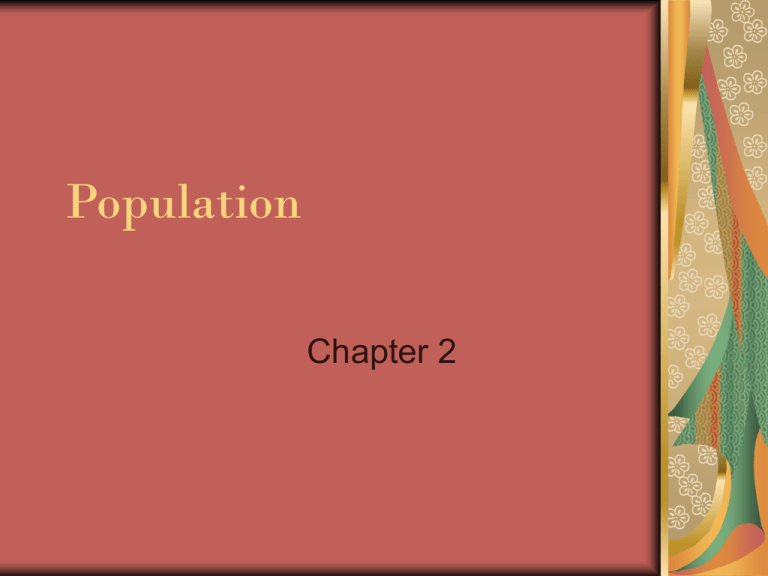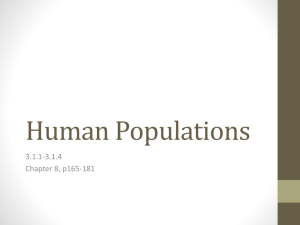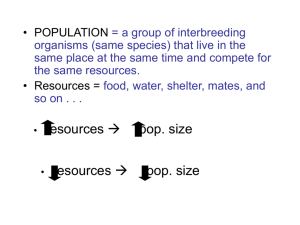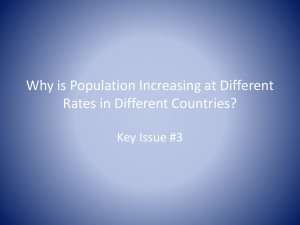Chapter 2: Population
advertisement

Population Chapter 2 Importance of Studying Population 6.75 billion people living on Earth— more than ever Population grew faster during second half of 20th century than ever before Almost all population growth is now happening in LDCs Demography Def.- the scientific study of population characteristics Demographers statistically study spatial distribution of people by age, gender, occupation, fertility, health, etc. Where is the World’s Population Distributed? Population cartogram- shows size of the country relative to its population rather than land area Population Concentrations 2/3 of people living on Earth are clustered around 4 regions East Asia South Asia Southeast Asia Europe continued Most of these people in these 4 regions live near an ocean or river with easy ocean access 2/3 of world live within 300 miles of an ocean– 4/5 within 500 miles 4 clusters are generally low in elevation, with fertile soils and a temperate climate Clusters located in N. hemisphere b/w 10 and 55 degrees latitude except for part of Southeast Asia East Asia 1/5 of the world Includes eastern China, Japan, the Korean Peninsula, and Taiwan 5/6 live in China Most along the coast or along Huang and Yangtze Rivers 26 cities with more than 2 million, 52 with more than 1 million—still 2/3 live in rural areas Most Japanese live in Tokyo and Osaka Most Koreans live in Seoul South Asia 1/5 of World’s population Includes India, Pakistan, Bangladesh, and Sri Lanka ¾ live in India Mostly rural populations- ¼ live in urban areas Europe 1/9 of World’s population Includes European section of Russia Over 4 dozen countries Unlike Asia, ¾ of Europeans live in cities Largest concentrations near coalfields of Germany, England, and Belgium Don’t produce enough food for themselves– import most of it Southeast Asia ½ billion people live here Mostly on islands b/w Indian and Pacific Oceans Java, Sumatra, Borneo, Papua New Guinea, and the Philippines Mostly farmers in rural areas Together the 3 Asian concentrations have more than half the World’s pop., living on only 10% of the Earth’s land area Other Population Clusters Largest cluster in Western hemisphere is NE US and SE Canada Chicago to Boston to Newport News About 2% of World population Only 3% farmers Another 2% in West Africa Most in Nigeria Like Asia, mostly agriculture Sparsely Populated Regions Relatively few people live in areas where it is hard to grow food Too dry, too wet, too cold, or too mountainous Ecumene- portion of Earth’s surface occupied by permanent human settlement Has grown over time Dry Lands 20% of Earth’s land surface is too dry for farming Still may have valuable natural resources such as oil reserves Two largest desert regions are b/w 15 and 50 degrees N lat. and 20 and 50 degrees S lat. Wet Lands Too much moisture can be inhospitable for humans Mostly b/w 20 degrees N and 20 degrees S latitude in South America, Central Africa, and SE Asia High rain and high heat lead to rapid depletion of soil nutrients If rains are seasonal, it may be possible to grow enough food to support a large population Cold Lands The poles are either covered in ice or permanently frozen (permafrost) Drier than most deserts– small annual snowfall just never melts Can’t grow food, therefore very few humans live in thee areas High Lands Highest mountains are steep, snow covered, and sparsely settled Exceptions------ people prefer higher ground if lower areas if temperature and precipitation are to high Ex. Mexico City One of the World’s largest cities, and its at an elevation over 7000 ft. Population Density Aka arithmetic density- total # of people divide by total land area Used to compare countries because the info. for computing is easy to obtain About 80 per sq. mile in US (31 per sq. kilometer) Bangladesh= 2700 per sq. mile (many people, small land) India= 900 (more people than US, less land) Canada= 8 (big land, few people) Manhattan island-68,000 continued Arithmetic density helps answer the “where” people live question To explain “why” people live where they do we need other measures Physiological Density Def.- the # of people supported by a unit of arable land In US, 445 per sq. mile (172 p/sq. kilo.) In Egypt, its 6,682 sq. mi Therefore, 1 unit of arable land in Egypt must feed far more people than in the US The higher the physiological density, the greater pressure that people place on the land to produce enough food continued Comparing physiological and arithmetic densities helps geographers understand the capacity of the land to yield enough food for the needs of the people If the physiological density is much larger than the arithmetic density, much of the country’s land mass is unsuitable for agriculture 95% of Egyptian population lives in the Nile Valley and Delta Agricultural Density Def.- the ratio of the # of farmers to the amount of arable land helps account for economic differences MDCs have lower agricultural densities because technology and finance allow a few people to farm extensive land area Allows pop. to work in other industries continued High physiological density paired with a low agricultural density means an that a country has an efficient agricultural system Natural Increase Three ways geographers measure pop. Change 1. Crude birth rate (CBR) – total # of live births in a year for every 1,000 people alive in the society 2. Crude death rate (CDR) – total # of deaths in a year for every 1,000 people alive in the society 3. Natural increase rate (NIR) – the % growth of a population in a year, computed as the crude birth rate minus the crude death rate continued NIR for world is currently about 1.2 All-time high was 2.2 in 1963 About 80 million being added each year Highest ever was 1989 when 87 million people were added With current pop. level, a change of .01% in the NIR causes a huge swing in pop. growth continued The NIR affects the doubling time» The number of years needed to double the population, assuming a constant NIR At current rate, doubling time is 54 years If remains constant, pop. will reach 24 billion by 2100 At peak NIR of 2.2 in 1963, pop. was doubling every 35 years – At constant 2.2 rate, 2100 pop. Would be 50 billion continued Almost 100% of natural increase is clustered in LDCs More than 2% in most of Africa, Latin America, and the Middle East Actually negative in Europe 2/3 of World pop. growth during past 10 years has been in Asia Fertility Total fertility rate (TFR) – the average number of children a woman will have throughout her childbearing years (15-49) Attempts to predict the future behavior of individual women in a world of rapid cultural change TFR for world is 2.7 Much higher in LDCs than MDCs Over 6 in some African countries Mortality Infant mortality rate (IMR)- the annual # of deaths of infants under 1 year of age, compared with total live births Per 1000 births Very high in Africa, very low in Europe A reflection of the country’s health care system US has a higher IMR than Canada and Europe – Many poor in US can’t afford health care continued Life expectancy- the average # of years a newborn infant can expect to live at current mortality levels Higher in MDCs– average late 70s Lower in LDCs- only 40s in most of Africa continued NIR, CBR, TFR, IMR, and life expectancy distributions follow similar patterns More developed regions have lower NIR, CBR, TFR, and IMR –with higher average life expectancy CDR does not follow this pattern The combined CDR is lower for LDCs than MDCs – This is due to their stages in the process of demographic transition Demographic Transition Def.- the process of change in a society’s pop. from a condition of high CBR and CDR and low NIR to a condition of low CBR and CDR, low NIR, and a higher total pop. 4 stages have been identified As a country moves from one stage to the next, it will never go back Demographic Transition Stage 1: Low Growth Most of human history fits this category CBR and CDR vary from year to year, but always remain high In effect they cancel out the possibility of pop. growth NIR basically zero continued Most were hunter/gatherers during this period Pop. would increase when there was an abundance of food, but would decrease when it was hard to come by About 8000BC the pop. began to grow by several thousand each year From about 5 mill. In 8000BC to 800 million in 1750 continued Agricultural revolution- when humans first domesticated plants and animals and no longer relied entirely on hunting and gathering There was now a more stable food supply, but it could still be unpredictable Therefore, stage1 continued because of things like war and famine No country still in this stage Stage 2: High Growth Soon after 1750 the World pop. grew 10 times faster than it had ever done In 1750 about ½ million people were added to the pop.– In 1800 5 million were added Some countries moved into stage 2 CDR plummets, while CBR remains high Leads to high NIR Continued Industrial revolution- a series of improvements in ind. technology that transformed the process of manufacturing goods Led to never seen before amount of wealth, which made some communities healthier places to live Machines helped farmers increase harvests and freed people to work in factories continued Sanitation and personal hygiene were improved, sewers were installed People were healthier and lived longer European and NA countries entered stage 2 around 1800 Most African, Asian, and Latin American did not until 1950 In 1900 8 million people were added, 2000 80 million were added continued The LDCs moved into stage 2 for different reasons than the MDCs Medical revolution- medical technology from Europe and US diffused to LDCs eliminating many causes of death and allowed people to live longer Stage 3: Moderate Growth CBR drops sharply, CDR slowly declines CBR still greater than the CDR, but NIR is not as high European and NA countries made the transition in the first half of the 20th century Most LA and Asian countries have recently moved Most African countries are still in stage 2 continued The sudden drop of the CBR is caused by a change in social customs People choose to have fewer children, they are more likely to live in cities and not on a farm—making children an economic liability instead of an asset, and urban homes often don’t have enough space for large families Stage 4: Low Growth CBR declines to the point where it equals CDR, and the NIR approaches zero Called zero population growth can occur when the CBR is slightly higher than the CDR because some females die before reaching childbearing years A TFR (total fertility rate) of 2.1 produces zero pop. growth (not counting immigration) continued Stage four countries can be identified by looking at a map of TFR In the US the TFR has moved slightly below zero population growth since 2000 continued Social customs again help explain the transition Women work outside the home, birth control is more accepted and more available Some European countries like Russia have negative NIRs (more deaths than births) – blame it on the communists—high pollution and unhappy people continued Demographic transition is almost like a cycle Stage 1 little or no natural increase Stage 4 little or no natural increase 2 major differences Stage 1 CBR is high 35-40, stage 4 it’s low 10 Total pop. Is much higher in stage 4 Demographic Transition Population Pyramids The stage of demographic transition gives a country a distinctive population structure Demographic transition effects the structure in 2 ways 1. 2. % of population in each age group Distribution of males and females Continued Population pyramid- a bar graph representing the distribution of population by age and sex Pop. % is broken down into 5 year age groups Men on the left, females on the right Shape determined primarily by CBR Stage 2 pyramid like—stage 4 rectangular Age Distribution Dependency ratio- the # of people who are to young or too old to work, compared to the number of people in their productive years The larger the % of dependents, the greater the burden on the working pop. continued The pop. Is divided in to three groups to compare dependency ratios 0-14 2. 15-64 3. 65 and older Group 1 and 3 are generally considered dependents 1. continued Stage 2 countries have about 50% dependents Stage 4 only about 33% Makes the dependency ratio 1:1 in stage 2 countries and 1:2 in stage 4 Young dependents outnumber elderly 10 to 1 in stage 2—about even in stage 4 countries Continued Stage 2 countries– 1/3 of pop. is under 15 Makes it hard for poorer countries to provide enough schools, hospitals, and daycares Stage 4 countries have a “graying” population US spends more than ¼ of budget on Social Security and healthcare for older Americans Sex Ratio Def.- the number of males per hundred females in the population Varies among countries In general, slightly more males are born, but they also have higher death rates In Europe in US it is 95:100, it is 102:100 in the rest of the world In US, males under 15 outnumber girls 105:100 until about age 40 Malthus on Overpopulation Wrote An Essay on the Principle of Population in 1798 Claimed that the population was growing much faster than the food supply Pop. Growing geometrically, food supply only arithmetically Malthus wrote this several decades after England entered stage 2 Believed pop. Growth would drain all countries of resources unless “moral restraint” was used to lower the birth rate or disease, famine and war raised the death rate Neo-Malthusians Argue that 2 char. of recent pop. growth make the theory even more scary 1. Most pop. Growth is in poor countries that don’t have many resources to begin with 2. World pop. Growth is outstripping other resources besides food (ex. Energy) Malthus’s Critics Viewed as unrealistically pessimistic because he assumed the world’s food resources as stable, not expanding Humans have the ability to adapt to the environment and sometimes adapt the environment (called _______________) Other critics argue that the World is better off with 6 billion people than 1 billion because of the economic development that has occurred Declining Birth Rates On a global scale Malthus’s theory has not come true Food production has increased faster than the NIR since 1950 NIR for the world declined in the 1990s from 1.8 to 1.3 Can only happen because of a rise in the CDR or a decline in the CBR Cont. The decrease in the NIR is largely the result of declining birth rates Has happened for two reasons 1. Economic development 2. Distribution of contraceptives Economic Development Wealthier communities have more money to spend on education and healthcare programs that lower birth rates If women go to school and learn employment skills they will have more economic control over their lives Distribution of Contraceptives In LDCs, demand for contraception is greater than the supply Which means if more are distributed, more will be used and birth rate will decline About ¼ of African women use contraceptives Economic, religious, and educational reasons for this World Health Threats In some countries high CDRs have resulted in the declining NIR Epidemiologic transition- distinctive causes of death in each stage of the demographic transition Epidemiologic Transition Stages 1 and 2 Stage one has been called the stage of pestilence and famine Infectious and parasitic disease were principal causes of human death Ex. Black Plague Stage 2 has been called the stage of receding pandemics – A disease that occurs over a wide geographic area that affects a very high proportion of the population Can be reduced by improved sanitation, nutrition, and medicine continued Death rates didn’t decline immediately in stage 2 after industrialization The working poor lived in overcrowded slums – had high death rates Ex. Cholera Epidemiologic Transition Stages 3 and 4 Stage 3 is known as the stage of degenerative and human-created diseases Decrease in deaths from infectious diseases and an increase in chronic disorders associated with aging Stage 4 known as the stage of delayed degenerative diseases Medical advances allow people to live longer even with degenerative diseases Epidemiologic Transition Possible Stage 5 Some argue for a stage of reemergence of infectious and parasitic diseases 3 reasons for possible reemergence 1. Evolution of microbes 2. Poverty leads to sub-par medical care 3. Improved travel continued Ex. Avian Flu Only a modest change in its makeup would make humans very susceptible Would become a pandemic AIDS 20 million have died and 40 million are infected worldwide Mostly effects LDCs now 25 million in sub-Saharan Africa








